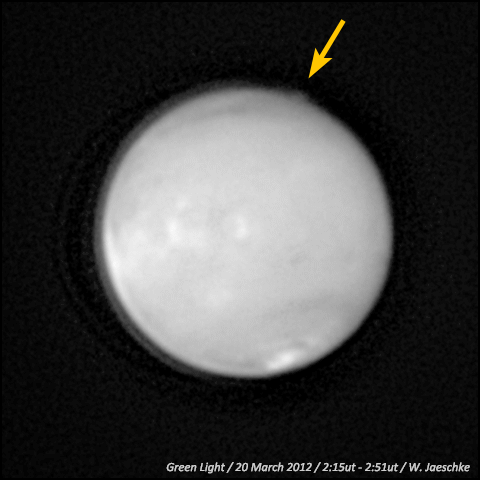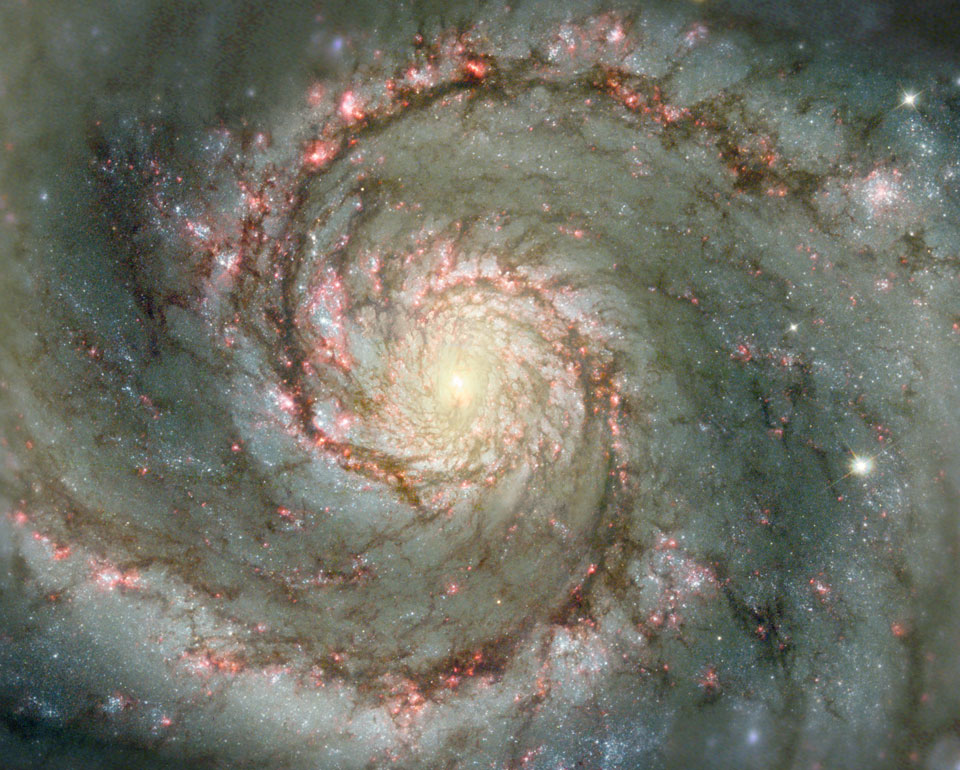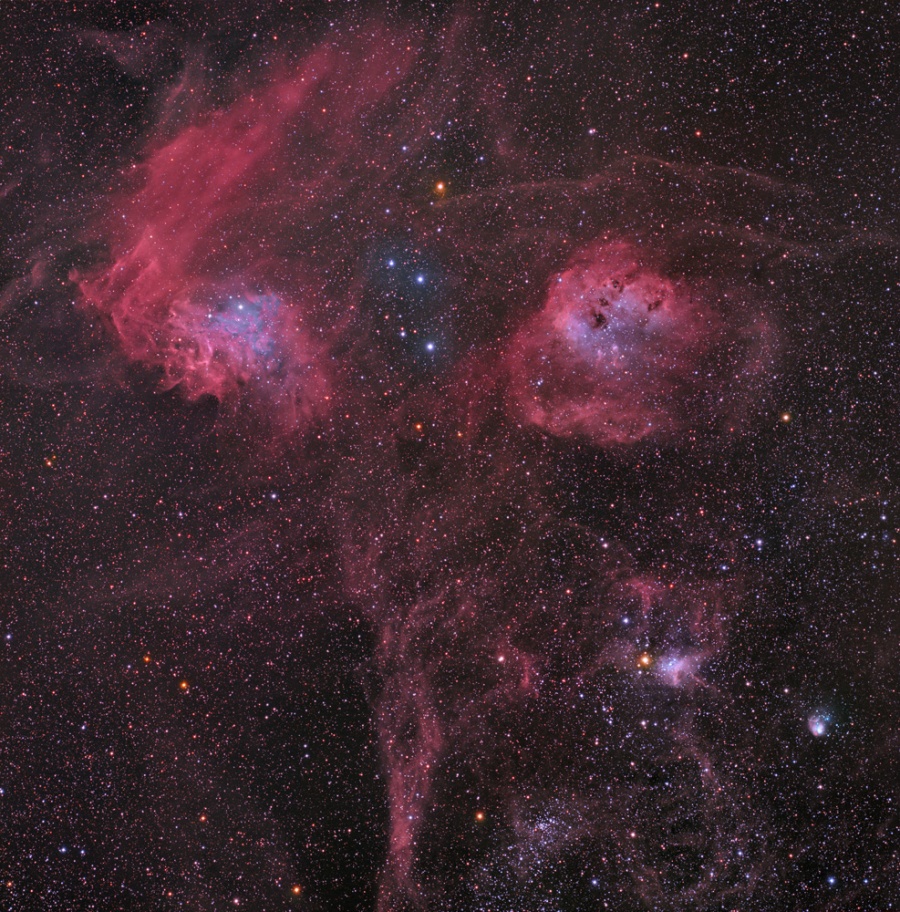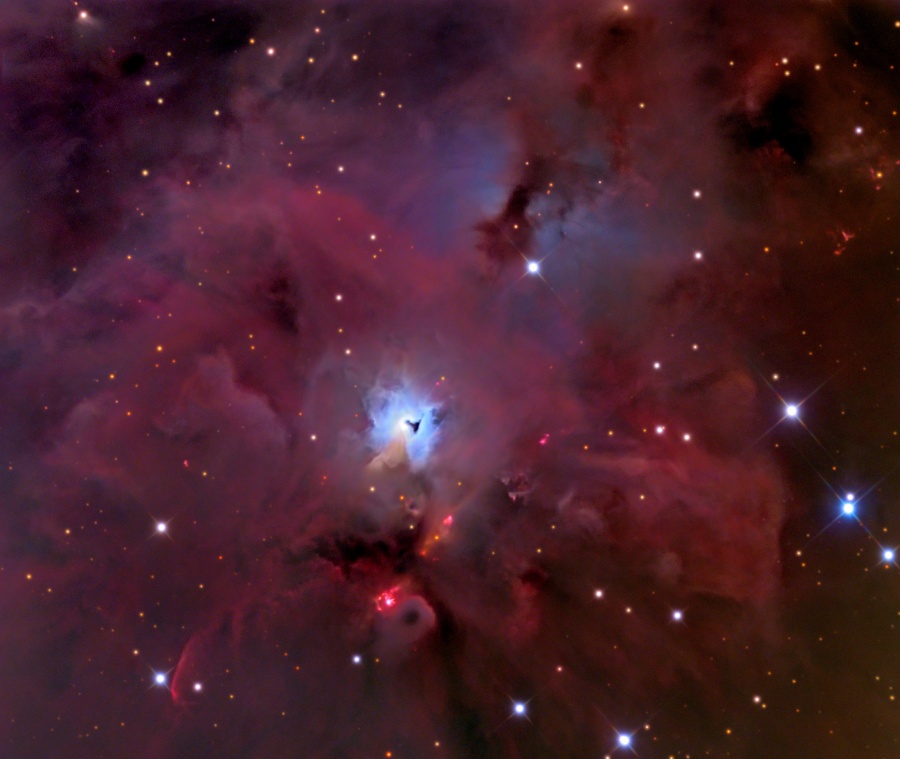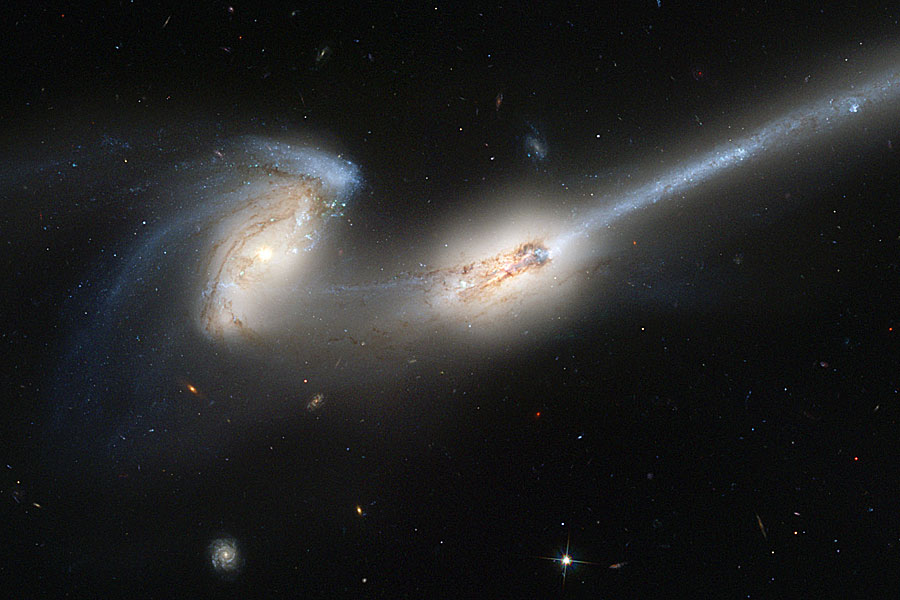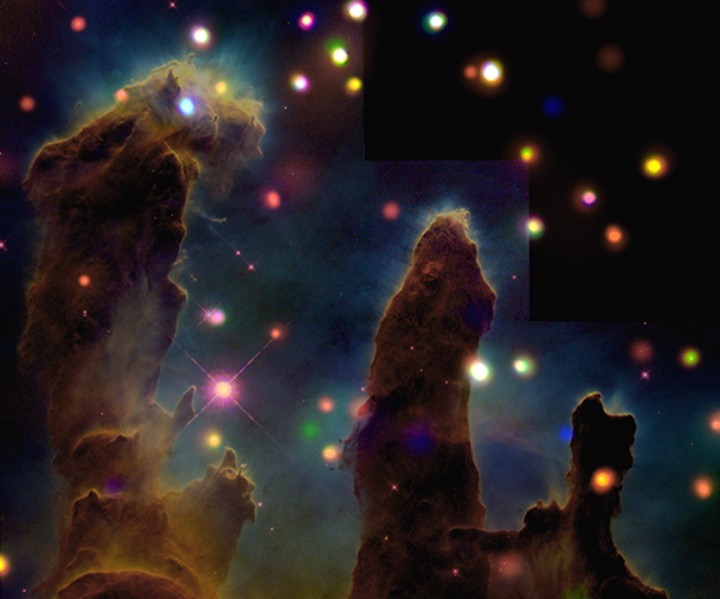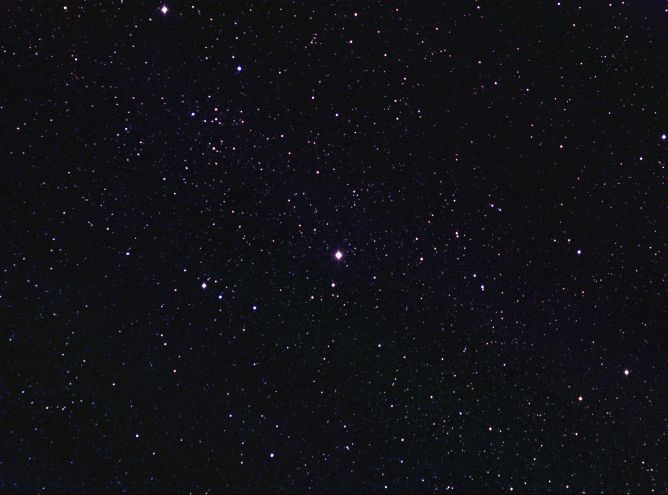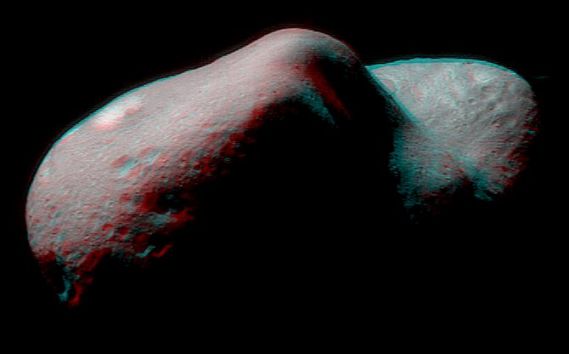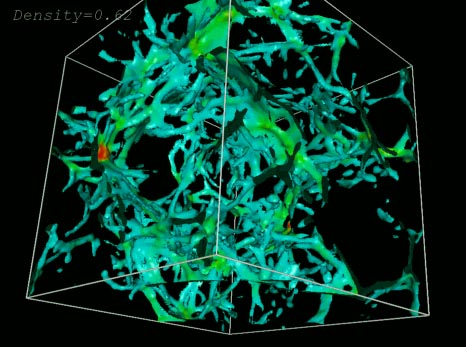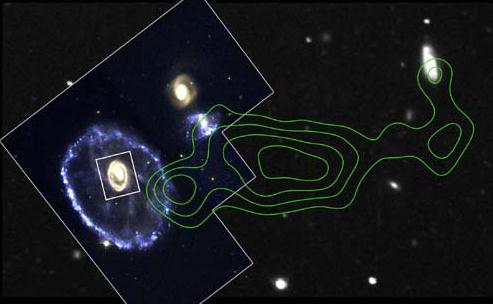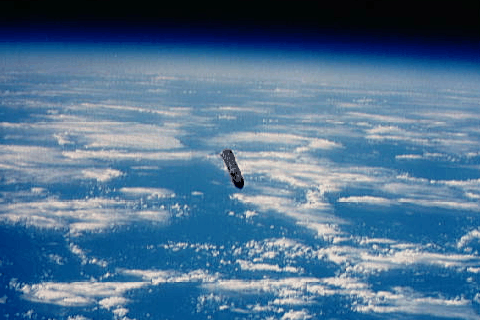| << Previous | Index | Next >> |
2015What is creating unusual plumes on Mars? No one is sure. Noted and confirmed by a global contingent of amateur astronomers on photos of the red planet in March 2012, possibly similar plumes have now been found on archived images as far back as 1997. Since the plumes reach 200 kilometers up, they seem too high to be related to wind-blown surface dust. Since one plume lasted for eleven days, it seemed too long lasting to be related to aurora. Amateur astronomers will surely continue to monitor the terminator and edge regions of Mars for new high plumes, and the armada of satellites orbiting Mars may be called upon to verify and study any newly reported plume that become visible. The featured 35-minute time-lapse animation was taken on 2012 March 20 by the plume's discoverer -- an attorney from Pennsylvania, USA.
2014
Click to play embedded YouTube video.
Image Credit: NASA's GSFC, W. Steffen (UNAM)
2013
2012 Rich in star clusters and nebulae, the ancient constellation of Auriga, the Charioteer, rides high in northern winter night skies. Composed from narrow and broadband filter data and spanning nearly 8 Full Moons (4 degrees) on the sky, this deep telescopic view recorded in January shows off some of Auriga's celestial bounty. The field includes emission region IC 405 (top left) about 1,500 light-years distant. Also known as the Flaming Star Nebula, its red, convoluted clouds of glowing hydrogen gas are energized by hot O-type star AE Aurigae. IC 410 (top right) is significantly more distant, some 12,000 light-years away. The star forming region is famous for its embedded young star cluster, NGC 1893, and tadpole-shaped clouds of dust and gas. IC 417 and NGC 1931 at the lower right, the Spider and the Fly, are also young star clusters embedded in natal clouds that lie far beyond IC 405. Star cluster NGC 1907 is near the bottom edge of the frame, just right of center. The crowded field of view looks along the plane of our Milky Way galaxy, near the direction of the galactic anticenter.
2011 South of the large star-forming region known as the Orion Nebula, lies bright blue reflection nebula NGC 1999. Also at the edge of the Orion molecular cloud complex some 1,500 light-years distant, NGC 1999's illumination is provided by the embedded variable star V380 Orionis. The nebula is marked with a dark sideways T-shape near center in this broad cosmic vista that spans over 10 light-years. The dark shape was once assumed to be an obscuring dust cloud seen in silhouette against the bright reflection nebula. But recent infrared images indicate the shape is likely a hole blown through the nebula itself by energetic young stars. In fact, this region abounds with energetic young stars producing jets and outflows that create luminous shock waves. Cataloged as Herbig-Haro (HH) objects, named for astronomers George Herbig and Guillermo Haro, the shocks appear bright red in this view that includes HH1 and HH2 just below NGC 1999. The stellar jets and outflows push through the surrounding material at speeds of hundreds of kilometers per second.
2010 This space job was almost complete. Floating just below the International Space Station, astronaut Nicholas Patrick put some finishing touches on the newly installed cupola space windows last week. Patrick was a mission specialist onboard the recently completed space shuttle Endeavor's STS-130 mission to the ISS. Pictured, Patrick floats near the outermost of seven windows on the new cupola of the just-installed Tranquility module. Patrick hovers about 340 kilometers over the Earth's surface, well in front of the blue sky, blue water, and white clouds pictured far in the background. In the above image, covers on windows three and four were in place and clearly labelled. Images from inside the ISS's new panoramic cupola are now available.
2009 Why is the Horsehead Nebula surrounded by a bubble? Although hard to make out, the famous Horsehead Nebula is the slight dark indentation in the bright streak just to the left of the image center. Glowing like an emission nebula, the origin of the bubble, known as Barnard's Loop, is currently unknown. Progenitor hypotheses include the winds from bright Orion stars and the supernovas of stars long gone. Barnard's Loop is too faint to be identified with the unaided eye. The nebula was discovered only in 1895 by E. E. Barnard on long duration film exposures. The above image was taken in a single specific color emitted by hydrogen to bring out detail. To the left of the Horsehead Nebula, visible as a small dark indentation, is the photogenic Flame Nebula.
2008 These two mighty galaxies are pulling each other apart. Known as " The Mice" because they have such long tails, each spiral galaxy has likely already passed through the other. They will probably collide again and again until they coalesce. The long tails are created by the relative difference between gravitational pulls on the near and far parts of each galaxy. Because the distances are so large, the cosmic interaction takes place in slow motion -- over hundreds of millions of years. NGC 4676 lies about 300 million light-years away toward the constellation of Bernice's Hair (Coma Berenices) and are likely members of the Coma Cluster of Galaxies. The above picture was taken with the Hubble Space Telescope's Advanced Camera for Surveys which is more sensitive and images a larger field than previous Hubble cameras. The camera's increased sensitivity has imaged, serendipitously, galaxies far in the distance scattered about the frame.
2007
2006 This pretty star field in the constellation Ophiucus is centered on a star not often seen - RS Ophiuci. In fact, early last week RS Oph suddenly became visible to the naked eye for the first time since 1985. A type of cataclysmic variable star classified as a recurrent nova, RS Oph dramatically increased in brightness from 11th magnitude, too faint to appear on some star charts. Historically, RS Oph was seen to go through only four similar outbursts since 1898. Such stars are now modeled as interacting binary star systems, composed of a compact white dwarf star co-orbiting with a swollen red giant. As material falls away from the red giant it collects in a rotating accretion disk before ultimately falling on to the white dwarf. Disk instabilities, or a build up of material on the compact star result in the occasional but rapid release of energy through nuclear burning. At an estimated distance of 3,000 light-years, RS Ophiuci is now reported to be fading rapidly. This telescopic view spans about 2 degrees (4 full moons) and was captured on the morning of February 16 from the RAS Observatory under New Mexico skies.
2005 Small, icy, inner moon of Saturn, Enceladus is only about 500 kilometers in diameter. But the distant world does reflect over 90 percent of the sunlight it receives, giving its surface about the same reflectivity as fresh snow. Seen here in a sharp view from the Cassini spacecraft's recent flyby, Enceladus shows a variety of surface features and very few impact craters - indicating that it has been an active world even though this tiny moon should have completely cooled off long ago. In fact, the resurfaced appearance of Enceladus could be the result of liquid water geysers or water volcanos. Since Enceladus orbits within the outer E ring of Saturn, the moon's surface may be kept snow-bright as it is continuously bombarded with icy ring particles. Eruptions on Enceladus itself would in turn supply material to the E ring. Interplanetary ski bums take note: tiny Enceladus has only about 1/100th the surface gravity of planet Earth and a surface temperature of -200 degrees C (-330 degrees F).
2004 What could rip a star apart? A black hole. Giant black holes in just the right mass range would pull on the front of a closely passing star much more strongly than on the back. Such a strong tidal force would stretch out a star and likely cause some of the star's gasses to fall into the black hole. The infalling gas has been predicted to emit just the same blast of X-rays that have recently been seen in the center of galaxy RX J1242-11. Above, an artist's illustration depicts the sequence of destruction (assuming that image-distorting gravitational-lens effects of the black hole are somehow turned off). Most of the stellar remains would be flung out into the galaxy. Such events are rare, occurring perhaps only one in 10,000 years for typical black holes at the center of typical galaxies.
2003 As Comet NEAT flared last week, the Sun roared. Just as the comet swooped inside the orbit of Mercury and developed a long and flowing tail of gas and dust, the Sun emitted a huge Coronal Mass Ejection (CME). Neither the fortuitous hot ball of solar gas nor the intense glare of sunlight appeared to disrupt the comet's nucleus. The action was too close to the Sun to be easily visible by humans, but the orbiting Sun-pointing SOHO satellite had a clear view of the celestial daredevil show. The above image was taken on February 18 when the comet was so bright it created an artificial horizontal streak on the camera image. During the encounter, Comet NEAT, official designation (C/2002 V1), brightened to second magnitude. An opaque disk blocked the Sun's image. The now-outbound comet remains bright but will surely fade as it moves away from the Sun. Nevertheless, Comet NEAT will likely be visible with binoculars to southern hemisphere observers for the next month.
2002 Sir Isaac Newton changed the world. Born in 1642, Newton was only an above-average student. But he went home from Cambridge one summer in 1665, thought a lot about the physical nature of the world, and came back two years later with a revolutionary understanding of mathematics, gravitation, and optics. A Professor of his, upon understanding what Newton had done, resigned his own position at Cambridge so Newton could have it. Newton's calculus provided a new mathematical framework for the rapid solution of whole classes of physical problems. Newton's law of gravitation explained in one simple formula how apples fall and planets move. Newton's insights proved to be so overwhelmingly powerful he was the first scientist ever knighted.
2001 This famous cosmic dust cloud was imaged in infrared light by the European Space Agency's Infrared Space Observatory (ISO) satellite. The false-color picture shows the bright infrared emission from dust and molecular gas in part of the Orion star forming region surrounding the Horsehead Nebula. In visible light, the horsehead-shaped dust cloud looks dark against a background of bright glowing gas. But in this image, the interstellar infrared glow engulfs much of the horse's head. Just above and to the right of center, only the top remains crowned by a bright, newborn star. The very bright object at the lower left is the reflection nebula NGC 2023, a dense concentration of interstellar gas and dust grains also associated with newly formed stars.
2000 Get out your red/blue glasses and float next to asteroid 433 Eros, 260 million kilometers away! Orbiting the Sun once every 1.8 earth-years, asteroid Eros is a diminutive 40 x 14 x 14 kilometer world of undulating horizons, craters, boulders and valleys. Its unsettling scale and bizarre shape are emphasized in this picture - a mosaic of recent images from the NEAR spacecraft processed to yield a stereo anaglyphic view. Along with dramatic chiaroscuro, NEAR's 3-D imaging provides important measurements of the asteroid's landforms and structures, and hopefully clues to the origin of this city-sized chunk of solar system. The smallest features visible here are about 30 meters across.
1999 Most bright stars in our Milky Way Galaxy reside in a disk. Since our Sun also resides in this disk, these stars appear to us as a diffuse band that circles the sky. The above panorama of a southern band of the Milky Way's disk was taken from Australia. A 40-minute exposure was used, and the colors were digitally enhanced. Visible are many bright stars, dark dust lanes, red emission nebulae, blue reflection nebulae, and clusters of stars. In addition to all this matter that we can see, astronomers suspect there exists even more dark matter that we cannot see.
1998 We live in a forest. Strewn throughout the universe are "trees" of hydrogen gas that absorb light from distant objects. These gas clouds leave numerous absorption lines in a distant quasar's spectra, together called the Lyman-alpha forest. Distant quasars appear to be absorbed by many more Lyman-alpha clouds than nearby quasars, indicating a Lyman-alpha thicket early in our universe. The above image depicts one possible computer realization of how Lyman-alpha clouds were distributed at a redshift of 3. Each side of the box measures 30 million light-years across. Much remains unknown about the Lyman-alpha forest, including the real geometry and extent of the clouds, and why there are so many fewer clouds today.
1997 In yesterday's episode our hero, the Cartwheel galaxy, had survived a chance cosmic collision with a small intruder galaxy - triggering an expanding ring of star formation. Hot on the intruder's trail, a team of multiwavelength sleuths have compiled evidence tracking the reckless galaxy fleeing the scene. Presented for your consideration: a composite showing a visual image of the Cartwheel galaxy (at left) and smaller galaxies of the Cartwheel group, superposed with high resolution radio observations of neutral hydrogen (traced by the green contours). The neutral hydrogen trail suggestively leads to the culprit galaxy at the far right, presently about 250,000 light years distant from the Cartwheel!
1996 Sixteen minutes after the liftoff of STS-29, the Space Shuttle Discovery's jettisoned External Tank (ET) is seen here, in a photograph by shuttle astronaut James P. Bagian, falling back towards Earth. The 154 foot long ET is the largest non-reusable component in the Shuttle system. After carrying over 500,000 gallons of liquid propellant to feed the shuttle's main engines during liftoff, its ultimate fate is to re-enter the atmosphere, break up and descend into a remote ocean area. The side of this ET shows a normal burn scar caused during the separation of one of the reusable solid rocket boosters.
| << Previous | Index | Next >> |
